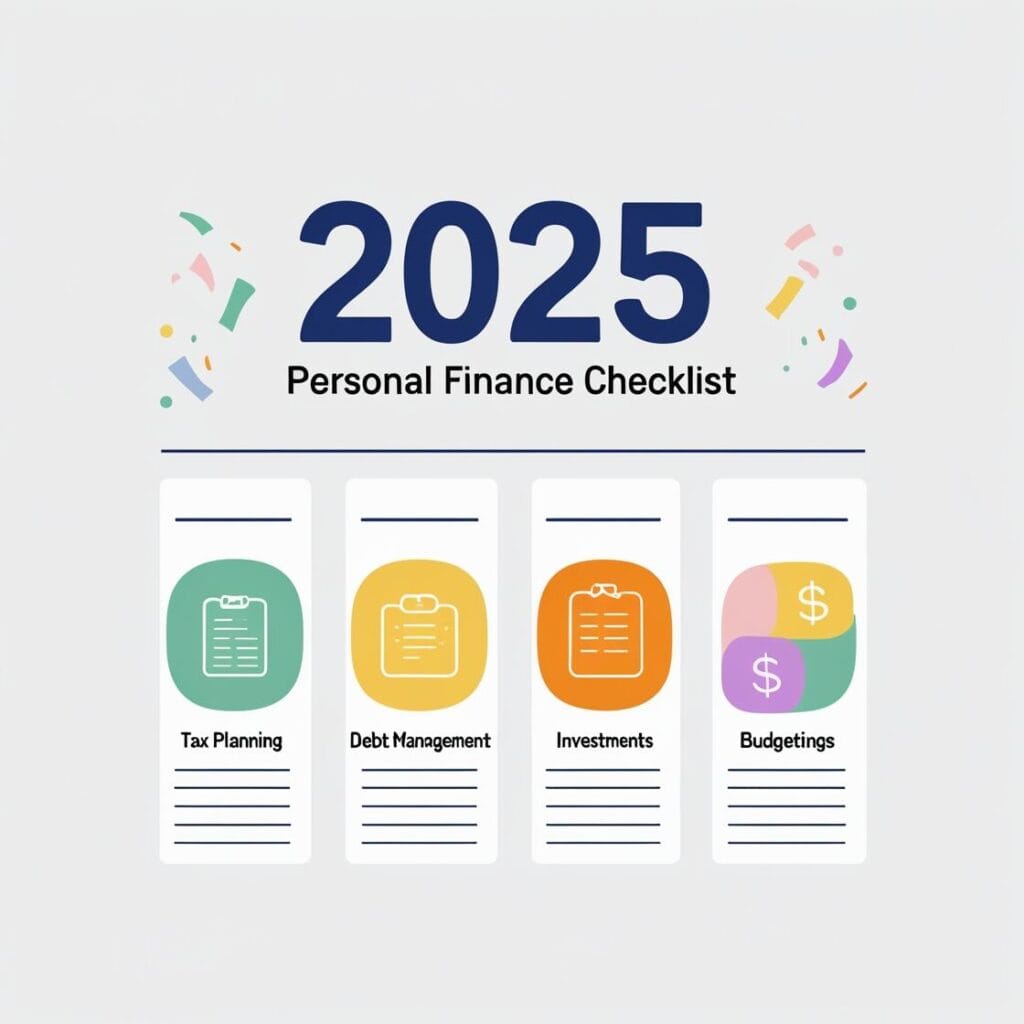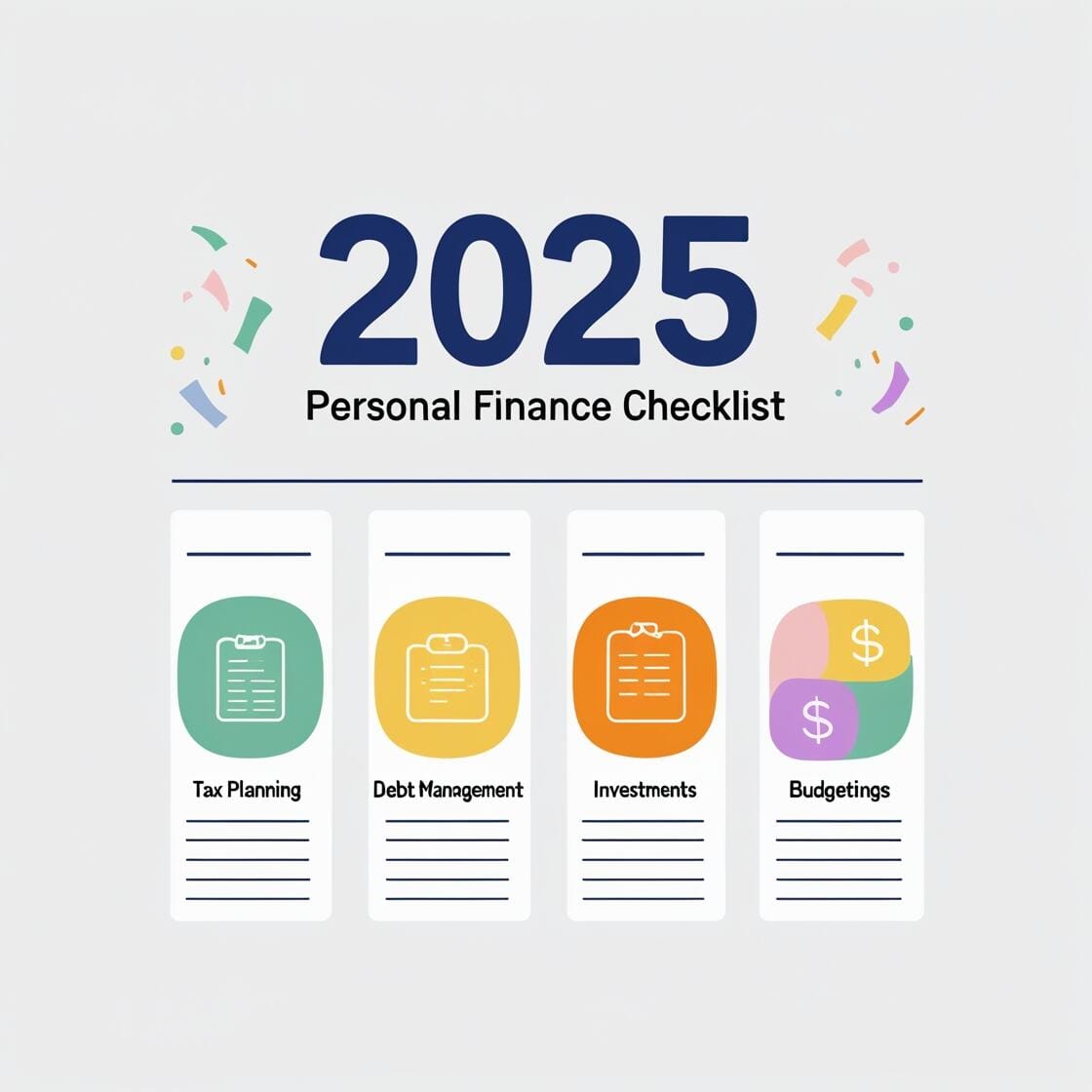Master your money in with these Personal Finance Tasks 2025 with this actionable guide! Discover tax hacks, debt strategies, investment trends, and budgeting tips to build wealth and achieve financial freedom.

Introduction
The year 2025 is crucial for taking charge of your money. Proactive planning can help you accumulate wealth, lower stress levels, and get ready for unforeseen circumstances in light of changing economic conditions, growing inflation, and new investment opportunities. This guide, which includes popular terms like AI-powered budgeting, ESG investing, and cryptocurrency tax methods, lists 10 essential personal finance tasks 2025, regardless of your status as a salaried professional, freelancer, or retiree. Let’s get started and automatically define your financial objectives!
Personal Finance Tasks 2025 you should consider
Here is list of steps you should take in Financial Year 2025-26
1. Audit Your Financial Health
Evaluate your financial situation at the beginning of the year. Utilise programs such as Mint or You Need A Budget (YNAB) to classify spending, examine bank statements, and determine your net worth (assets less obligations). Find spending leaks and establish goals for investments, debt repayment, and savings.
Pro Tip: To automate expense classification and obtain real-time insights, use AI-powered solutions like PocketGuard or Cleo.
2. Optimize Tax-Saving Investments Early
Increase your Section 80C (₹1.5 lakh) and Section 80CCD (1B) (₹50,000 for NPS) deductions by making early investments in:
- Equity-Linked Savings Plans (ELSS) offer the possibility of equity gain with a three-year lock-in.
- The National Pension System (NPS) offers extra tax advantages together with a safe retirement fund.
- Public Provident Fund (PPF) offers Long-term objectives with risk-free, tax-free profits.
Action Step: To take advantage of compounding and prevent year-end rush, begin a SIP in ELSS by April 2025.
3. Build a Robust Emergency Fund
The goal is to accumulate 6–12 months’ worth of living costs in a liquid mutual fund or high-yield savings account. Put this fund first in 2025 as a safety net against inflation, medical crises, and job loss.
Trending Tip: Look into online banks with interest rates between 5 and 7% for emergency funds.
4. Reduce High-Rate Debt
Sort debts by interest rate (home loans > personal loans > credit cards). Employ tactics such as:
- Debt Snowball: For immediate gains, pay off the smallest obligations first.
- Balance Transfer: Transfer the balance to a credit card with 0% annual percentage rate.
- Prepayment: Lower principal by using bonuses or additional revenue.
Pro Tip: Use applications like Cred or DebtPayoff Planner to bargain with lenders for reduced interest rates.
5. Revise Your Insurance Plan
- Health insurance: Claim up to ₹75,000 under Section 80D; renew policies with coverage of ₹5+ lakh.
- Term Life Insurance: Make sure your term life insurance policy covers ten times your yearly income.
- Critical Illness Riders: If workplace coverage is inadequate, add Critical Illness Riders to the policy.
2025 Trend: AI-driven insurance companies, such as Lemonade, provide individualised, cost-effective plans.
6. Automate Retirement Contributions
Increase NPS Tier-1 or Employee Provident Fund (EPF) contributions. Invest 50% or more of your income in index funds or rental properties to follow the FIRE (Financial Independence, Retire Early) approach.
Tool Alert: To determine your corpus requirements, use ET Money’s Retirement Calculator.
7. Use Trending Investments to Diversify
- ESG Funds: Put money into environmentally friendly businesses (like the SBI ESG Fund).
- Digital Gold: Purchase digital gold through Paytm Gold or similar platforms to hedge against inflation.
- Crypto: Track the 2025 crypto tax regulations and allocate 1% to 5% of your wealth to Bitcoin and Ethereum.
Be cautious: To control risk in erratic markets, rebalance investments every three months.
Also Read: 8-4-3 Compounding Rule Explained: The Secret to Building Wealth Faster
8. Adjust Your budget to Account for Inflation
- 50/30/20 Rule: 50% needs, 30% wants, and 20% debt or savings is the 50/30/20 rule.
- Zero-Based Budgeting: Give each rupee a specific function.
- Subscription Audits: Use Rocket Money to terminate any unused services.
9. Strategically Plan Major Expenses
- Home Loans: If the RBI raises interest rates, lock in fixed rates.
- Education: For the future of children, launch a Sukanya Samriddhi Yojana.
- Travel: Earn miles on trips in 2025 by using travel reward credit cards.
10. Stay Updated on Financial Regulations
- New vs. Old Tax Regime: Compare the savings of the New and Old Tax Regimes after the Budget 2025 changes.
- Capital Gains Tax: Arrange asset sales to minimise property and stock taxes.
Conclusion
Your year to develop financial development and resilience is 2025. You can confidently handle changes in the economy by automating savings, diversifying your investments, and avoiding debt. Review this checklist every three months and make adjustments as your life changes!
FAQs on Personal Finance Tasks 2025
Q1: Which investment will save the most money on taxes in 2025?
A: ELSS funds provide both high returns and tax savings (Section 80C).
Q2: How much money should I put into cryptocurrency?
A: Because of volatility, limit exposure to 1% to 5% of your portfolio.
Q3: In 2025, will the new tax system be superior?
A: After Budget 2025, use IT calculators to compare the two regimes.
Q4: How can I begin investing in ESG?
A: Investigate mutual funds with an ESG emphasis using sites like Zerodha.
Q5. How much money should I set aside for emergencies in 2025?
A: Depending on dependents and work security, aim for three to six months’ worth of living expenditures. For convenient access, keep it in a liquid mutual fund or high-yield savings account.
Q6. Which investments in FY 2025–2026 offer the biggest tax savings?
A: The best choices are NPS (retirement-focused with additional tax benefits), PPF (risk-free returns), and ELSS funds (for equity growth). Under Section 80C, a maximum of ₹1.5 lakh is allowed.
Q7. How can I reduce my debt by 2025?
A: Employ the debt avalanche (target high-interest loans) or snowball (pay the smallest debts first) strategies. Think about negotiating reduced interest rates or transferring balances.
Q8. Is it safe to invest in cryptocurrencies in 2025?
A: Cryptocurrencies fluctuate a lot. To minimise surprises, allocate just 1% to 5% of your portfolio and keep up of the 2025 crypto tax regulations.
Q9. In 2025, should I select the old or new tax regime?
A: Use the Income Tax Calculator after Budget 2025 to compare the two. Investors who claim exemptions may benefit from the old regime, while those with less deductions may benefit from the new one.
Disclaimer
This blog post’s content is intended solely for general informational purposes and does not represent expert financial, tax, or legal advice. Prior to making decisions based on your particular situation, speak with a licensed financial planner, tax advisor, or legal professional. Following publication, market conditions, tax laws, and regulations may change. Any losses or damages resulting from actions made in response to this content are not the responsibility of the author or publisher. We do not recommend third-party services; external links are merely for reference.
For Further reference consider following:

